Costa Rica, Part 2
Ellyn Bush and Tom Davis
Last Updated: August 4, 2002
You can click on almost any image (anything but the Basilisk lizard
and the Amazon kingfisher) on this page to see a larger version.
This page documents the second half of our trip to Costa Rica in
2002. You can read about the first half (which Tom Did by
himself) by clicking
here. During this second half, we spent time at the Arenal
volcano, in Monteverde, and in Palo Verde.
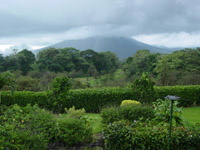
Arenal in the clouds
The second half of Costa Rica 2002 began with Tom, Ellyn, Freddy
and Barbara on the hunt for a live volcano. We made reservations
at the Arenal Lodge in order to have the perfect view of the
Arenal volcano. This photo is from our balcony. Upon our
arrival, we were disappointed to find the top of Arenal
completely cloud-covered. We ended up staying 4 days, and having
other non-volcano-related adventures (see below).
By the end of the 4 days (well, three nights), we had joked about going
into any restaurant in town and taking a photo of the photo of Arenal
which is on the wall of each. Then we could use Photoshop to paste
images of ourselves in the photo.
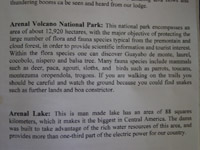
Further Lands
Given our lousy weather, we checked out the hotel brochure for
other activities around Arenal. We were amused to find a warning
indicating one should be careful when hiking because "you could
find snakes such as further lands and boa constrictor." Clearly,
the spell-checker was not familiar with the fer-de-lance. Well,
what probably happened is that the author was not a native English
speaker, and although the snake's name was spelled correctly by
him, when the spell-checker suggested "further lands", he meekly
went along with it.
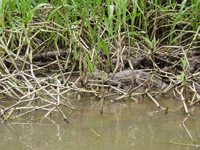
Caiman
We took a boat ride along the Rio Frio toward Caño Negro.
We asked why the river had this name, and the boat driver said it
was because Costa Ricans like to name things the opposite of what
they are. Although this was billed as a trip to the lake,
Caño Negro, we spent 4 hours in the boat and never
actually made it to the lake. It was hot, muggy and whenever we
stopped, we were attacked by hundreds of mosquitos. However, the
animal viewing along the shore was quite good, including caimans
(Caiman crocodilus), bats, lizards and kingfishers.

Kingfisher on a stick
Especially kingfishers. There were hundreds of them, and of all
sorts. Tom is a sort of kingfisher nut, and this river ride was
pure heaven for him. It would have been great to see the real
Caño Negro, however.
Here is an Amazon Kingfisher.
We were pretty pissed by the tour. It was not a problem with the
guide and route, but the fact that we were told that we were going
into the park and we didn't. In fact, when we questioned the
price originally (it was about $50 per person), we were told that
it included, among other things, a park entrance fee which
accounted for $6 of the price. It's the same thing that happens
on the vast majority of tours to Tortuguero (which is another
national park in Costa Rica) as well; the boats race through the
park to take you to lodges on the other side where you spend your
time. At least they do go through the park on the way to the
lodges, however.
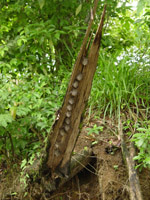
Bats on a stick
Here are a bunch of bats lined up under a dead rotting trunk
that's overhanging the Rio Frio. For some reason, bats love to
do this. We've seen them lined up like this on many occasions.
It's no doubt quite safe for the bats; what predator is going to
risk falling into a fast-moving caiman-infested river by climbing
a branch that overhangs the river?
On your first trip to any neotropical country where you take
nature tours like this, you're always amazed when the guide finds
a row of bats like this. One guide told us that the bats are in
the same place every day for years; they find a good spot and
stay there.
On this same trip, the guide was able to point out to us in a
manner that would have been completely magical, a Great
Potoo—a large owl-like or nighthawk-like bird that is
almost completely nocturnal, and while it is resting, it is
almost invisible on a tree trunk. Well, our guide admitted that
this one had been on exactly the same spot on the trunk for the
13 years since he found it.
The potoos are wonderful birds however. It was impossible on
this trip to get a photo; he was way up in the tree, but I do
have a photo taken the year before not of the Great Potoo, but of
the Common Potoo. It is near the bottom of this web page.
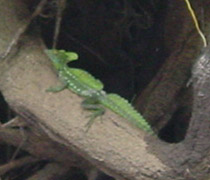
Jesus Christ Lizard
This Basilisk lizard, otherwise known as Jesus Christ Lizard, as
it is famous for "walking on water", by forcing a tiny air bubble
under its feet with each step. It also takes its steps amazingly
rapidly. Sometimes you will see one on the bank of a river, and
suddenly there's a blinding flash of motion, after which the
lizard is calmly standing on the opposite shore, and there is a
line of splash marks on the surface of the water.
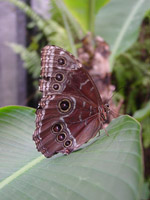
Butterfly
At the lodge in Monteverde there was a butterfly farm which was a
large screen-enclosed building. It was mesmerizing sitting
inside, with hundreds of butterflies flapping around your head.
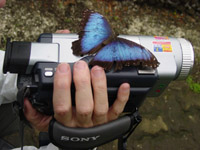
Morpho on camera
The morpho butterflies are beautiful and thus they are a favorite
in butterfly gardens. This was true at the lodge in Monteverde
as well, and inside there were morphos all over the place, and
here's one that perched on Ellyn's camera.
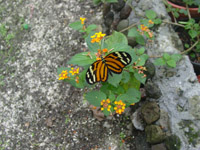
Heliconius butterfly
Here's a nice heliconius butterfly sitting on a lantana plant.
These butterflies are all poisonous (or at least pretty
foul-tasting) to birds, so they are protected from predation
since each bird eats one and usually decides never to try another
one like it again. The butterflies therefore engage in a kind of
mimicry where they evolve to look like one-another. In this case
they are all poisonous, but still, the bigger the group of
similar-looking animals that are poisonous, the easier it is for
the birds to learn not to eat them.
Tom did an Earthwatch project in Ecuador in 1998 where we studied
exactly this mimicry in the heliconius butterflies. It was a
real adventure. You can read about it here, where
you'll find a lot more details on this sort of mimicry. But
mostly you should read it for the adventure.
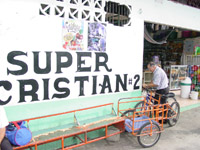
Super Cristian
Freddy and Barbara's car suffered a flat tire on the journey to
the lodge, and we went into the little town of Fortuna to get the
tire repaired. Tom was very pleased to find the grocery store
named "Super Cristian", especially because he felt they were more
honest than most: they displayed the vast supply of hard liquor
right up front near the checkout stand.
Freddy was fascinated by various insects and other small
creatures. He enjoyed observing the large streams of leaf-cutter
ants we would come upon occasionally, all marching in one
direction, carrying a large section of freshly cut leaf. However,
he couldn't leave well enough alone, and had to interact with
them somehow. Frequently, he would turn one of the ants around
180 degrees and set it back down on the trail, and then wait for
it to figure out it was going against traffic. He was pleased to
find it was merely a matter of seconds before the little guy
figured it out, and turned himself around.
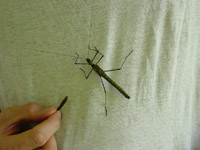
Walking stick
The insects were mutually attracted to Freddy, as evidenced by
this walking stick on his shirt.
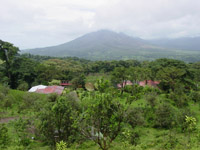
Arenal in the clouds
By our last day at Arenal, our view of the volcano was the same,
completely cloud-covered. We had heard no eruptions, saw no
lava, and began to think that the pictures of the erupting
volcano in every restaurant and tourist spot in town were a giant
hoax.
We then went to the Monteverde Cloudforest Reserve. We traveled
across Lake Arenal in a small, uncovered boat in the rain, and
took a small bus up into the cloudforest to the Hotel Villa Verde
where we stayed the next two nights. The hotel is conveniently
located just 1.5 kilometers from the park entrance. Barbara and
Freddy stayed at a nearby hotel, but arrived later, as they were
coming by car. Tom and I did a 4 hour hike upon our arrival,
and didn't see half the amount of wildlife we then saw the
following day, when the four of us took a tour of the cloudforest
reserve with a guide.
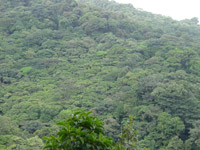
Cloudforest
This view is from the top of one of the trails, and looks out
over the forest. Though it is extremely dense, one can still
appreciate breaks in the canopy, where light (and rain!) can
penetrate.
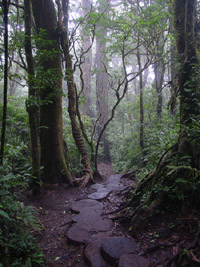
Strangler Fig
This is a photo of the same strangler fig which Tom took on our
first trip to Costa Rica. In fact, it's probably the most
photographed strangler fig in Costa Rica. It looks bizarre, is
right on a main trail in one of the most popular tourist
attractions in Costa Rica, Monteverde. For proof, take a look at
a photo near the top of this page, for
example.
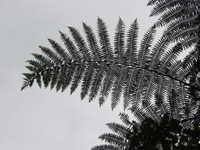
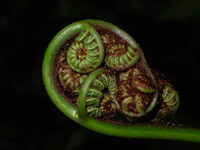
Fern
Given the cloudforest weather conditions, the trails there were
spectacular with plant life, especially ferns.
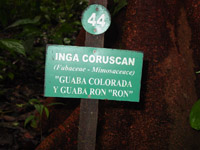
Guaba ron ron ron, da doo ron ron
Some of the plants in the reserve are labeled along the trail,
and upon seeing this one, we were instantly reminded of the
famous song from the 60s by The Crystals, entitled Da Doo Ron
Ron.... "I met him on a Monday and my heart stood still, da doo
ron ron ron, da doo ron ron, Somebody told me that his name was
Bill..."
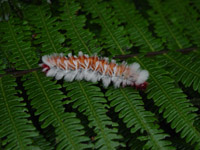
Caterpillar on Fern
Caterpillars are abundant in this reserve, many elaborately
decorated and brightly colored.
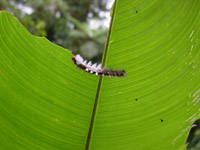
Caterpillar eats leaf
One can appreciate the rate at which the forest is consumed by
these animals, which are basically leaf-eating machines, leaf in
and frass out (see Tom's description of the Earthwatch expedition that
made up the first half of this trip).
At the park entrance at Monteverde were a table and benches where
one could sit and eat, or wait to meet up with the guides, etc.
Just waiting at this spot, we had some of our best sightings:
including a fox and an Orange-bellied Trogon.
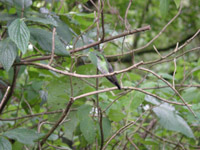
Hummingbird
Also at the park entrance there was the obligatory hummingbird
feeder, which was constantly visited by at least 5 species of
hummingbirds.
We were probably able to make reservations so easily at the last
minute everywhere as it was the "off" or rainy season. The
reason it was called the rainy season was apparent to us from Day
#1, however, in truth, the rain didn't really hamper any of our
plans significantly. It was often nice in the mornings, and
rained late in the day or in the evening, and by then, we were so
tired from hiking that sitting and drinking a cold beer watching
the downpour was a welcome activity.
Our last night there was one of the most impressive thunderstorms
we've ever experienced. There was an incredible amount of
rainfall in a short period of time, but even more frightening was
the volume of the thunder (remember, we're near the top of this
cloudforest, in a wood-sy lodge). At one point, the building was
struck by lightening, and this was louder than any noise I'd ever
heard (including zurna, tupan, etc.).
The hotel staff was looking very worried at that point. Of
course, their phone line was out, and their computer was
apparently "fried" through the modem. I figured that would be
enough to frustrate anybody in the hotel industry. No, in fact,
they didn't really care about the lack of those communication
devices. What concerned them was the satellite dish and TV being
out, and the finals for the world cup soccer were to be played
the following day.
This lack of phone line nearly hindered our leaving Monteverde
the following day. We were to catch a bus leaving from the
nearby town of Santa Elena at 7:00am, and the staff had told us
that if we showed up at the office at 6:20, they'd call a taxi
for us. We showed up on time, and found the office locked and
staff asleep, and unarousable. Eventually, after pounding on
some doors until nearly 7:00, we managed to awaken somebody, who
then discovered the phones were indeed still out. He simply ran
out to the street and flagged down a random driver going by, who
agreed to take us to the bus station in the nearby town. By that
time, it was already 7:00, and we figured it was hopeless, and
anticipated having a 3 hour breakfast in town while waiting for
the next bus out.
We drove up the dirt road into town, and suddenly encountered a
bus driving out in the other direction. The driver pulled our
car in front of the bus, forcing it to stop, and he jumped out
and told the driver we had to get in. The driver happily got
out, stowed our luggage underneath the bus, and we were one our
way with a 3 hour bus ride toward Palo Verde.
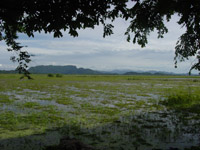
Palo Verde Marsh
We had been to Palo Verde, near the Tempisque River, together
several years ago. We wished to return there to see our friends,
Nicole and Mauricio, and experience it in the rainy season,
which, it turns out, is quite different compared with the dry
season. We realized why the verde in Palo Verde!
The final portion of our trip to Palo Verde consisted of a taxi
ride from the highway into the research station), and took a bit
longer than expected. We got off the bus at Caño, and got
a taxi driver to agree to take up on the one hour plus ride out
to the station. The taxi was more like a modified little truck,
and we were riding along when suddenly, the car came to a stop,
and the driver got out, opened the hood, and scratched his head
for a long time. We were on a dirt road and there was flat
pasture as far as one could see in any direction. The clutch
cable had broken, and though he was able to depress the pedal to
the floor, nothing happened. The driver was thus unable to
change gears.
He was, however, able to restart the engine in gear (as long as
it was first gear) and crawl along in first gear for awhile, but
soon the driver was worried he would burn out the engine, so he
cleverly stopped at the top of a little hill, pointing downhill.
Then he shut off the engine, and put it into second gear. As the
car rolled down with the help of the starter motor, he managed to
get it started, and we successfully completed the trip in second
gear. Of course we couldn't stop for anything or we'd kill the
engine. We don't know how he got back; presumably the same way.
While at Palo Verde, we took a boat ride along the Tempisque
River, but this trip was more successful than when we last
visited it. (Several years ago, we found a guy to take us out in
a little boat along the river to the Isla de Pajaros to view the
nesting storks. On our way back, I suddenly noticed water
flowing into the boat, nearly to Tom's ankles, and Tom recalls me
asking him why this was so! We discovered a rather substantial
leak in the bottom of the boat, and had to bail like crazy.
However, the water kept flowing in, and we ended up having to sit
toward the rear and gun the engine to point the nose of the boat
up, and keep the hole above water. We made it back safely,
though were concerned, as the river was loaded with crocodiles.
The following day we went back, and the boat was gone.) Below
are the crocodiles which we feared...
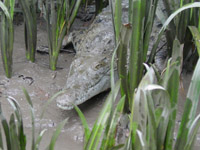
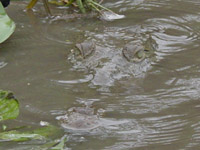
Crocodile
There were lots of crocs in the Tempisque river!
During our other days at Palo Verde, we explored the hiking
trails on our own. It was quite hot and humid, and much more
lush and green than on our previous trip there in the dry
season. Tom had been helping with an Earthwatch project
involving ants and their relationship to the acacia plant. At
Palo Verde, we saw several species of the bullhorn acacia, with
which these ants have a symbiotic relationship. I had more of a
personal experience with these ants, as I brushed a bit close to
one of these acacia guarded by the ants, and one ant dropped down
on my collar. I received to hefty stings on the neck from these
little buggers. Though they are tiny, and we are so used to ants
being harmless in California, I was impressed with the pain
associated with this sting (about 10 minutes' worth of
swearing...)
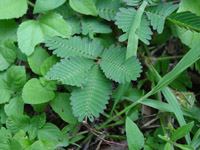
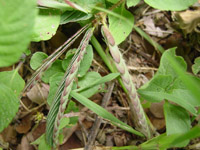
Open and Closed Acacia
There is another species of acacia, not protected by ants, but
rather with another self-protecting mechanism. The leaves are
normally spread out, in fan-like fashion, until touched. When
something (e.g. an animal) brushes up against it, or as in this
case, when I touch it with my hand, the leaves promptly close up
in about 2 seconds, and remain shut for a period of time, thus
making them less amenable to being eaten. On the left is the
open acacia and on the right is the same on in a closed state.
Around the research station, there were large iguanas, about 1
meter long. They would hang out on the grass, and bob their
heads up and down as some type of iguana signal, the sight of
which could have been enhanced had we put a set of headphones on
them. They were very adept at climbing the trees, and
occasionally, while sitting outside, we would hear a sudden
"whomp", when one of these large fellows would simply fall out of
the tree nearby and race off.
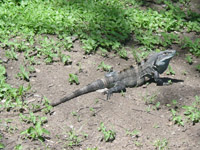
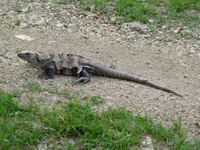
Iguana
The iguana on the right is shedding its skin. If you click on the
thumbnail image, you may be able to see the shedding skin.
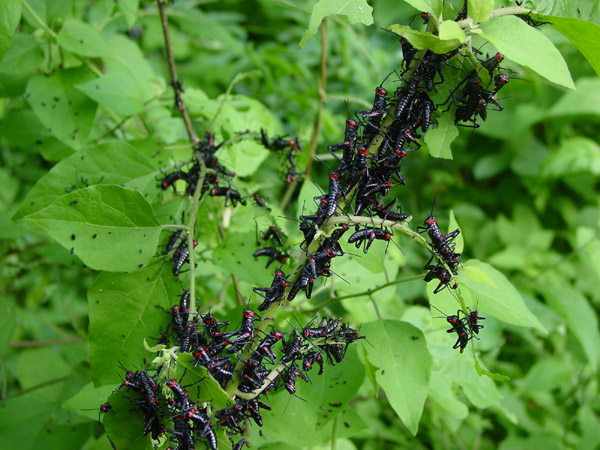
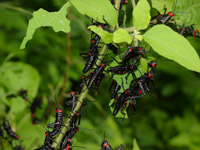
Load of Black Grasshoppers
On one of our hikes, we discovered one bush which was absolutely
covered with the same species of grasshoppers, and figured they
must have just hatched.
The research station had a soccer team which consisted of guys
largely in their 20s probably, and they would play other local
town teams on Thursday nights. They had official uniforms, and
one could tell that this was a sport taken very seriously. Also
at the research station, we met three (female) students from
Wellesley, who were working on a summer project in Costa Rica,
apparently having to do with farmer environmental education. One
day, these students and Mauricio asked Tom if he'd like to join
them in a game of ultimate frisbee. Tom hadn't really played
much frisbee, but figured he knew how to throw one, probably much
better than the Costa Ricans, and at least his skill with the
frisbee would make up a little for his advanced age (53). He was
secretly relieved that they hadn't ask him to join in on a soccer
game.
At 5:00pm, he showed up as instructed, wearing running shorts, a
T-shirt, and his hiking/running shoes. At that point, they all
somehow decided they were going to play soccer instead, and Tom
was drafted to play. The "field" was the former airplane landing
strip, which probably hadn't been used for its intended purpose
for years. It was next to the marsh pictured above, and also
adjacent to a large cow pasture.
After about 90 minutes, Tom returned, completely exhausted,
dehydrated and bedraggled. I don't recall him looking that bad
after any of the marathons he had done. It was nothing that
rest, dinner and lots of fruit juice couldn't cure. However, as
we were going to bed, we were impressed by the sight of his feet:
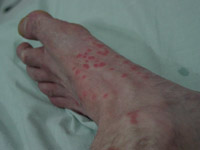
Tom's foot with chiggers
We had always
been warned of chiggers, and knew they were especially abundant
in areas near cow pastures. Well, that is certainly correct!
Though Tom had insect repellent on his legs, he had neglected his
feet, or to spray his socks or shoes (which the other players
knew to do). There is also a theory sulfur powder, applied to
areas where clothing is tight, such as ankles, waistline, etc.)
also helps to prevent the chigger bites, but Tom has usually
gotten around that by simply wearing knee-high rubber boots. The
boots perhaps would have prevented the gashes he received in the
shin during the soccer game (not pictured), but they would have
made playing a bit awkward.
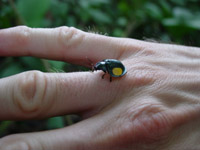
Beetle on Hand
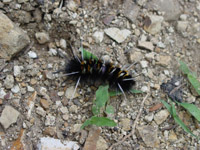
Black Caterpillar
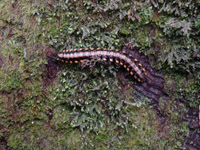
Millipede
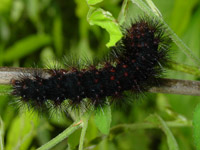
Fuzzy black caterpillar
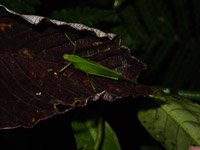
Katydid
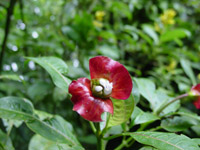
Labios de puta
The translation of the name is "whore's lips", for obvious reasons.
The bright red is not petals, but a bract. The plant is in the
genus Psychotria, family Rubiaceae.
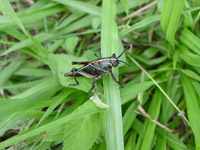
Lone grasshopper
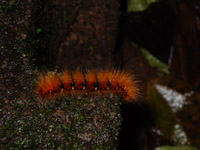
Orange Caterpillar
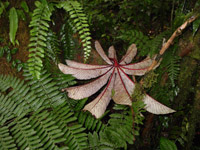
Plant Art
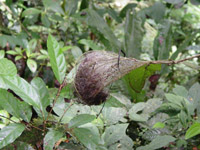
Spider Web
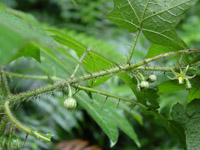
Spiny Solinacea
Want to send me mail? Click here: tomrdavis@earthlink.net.
Return to my home page.
















